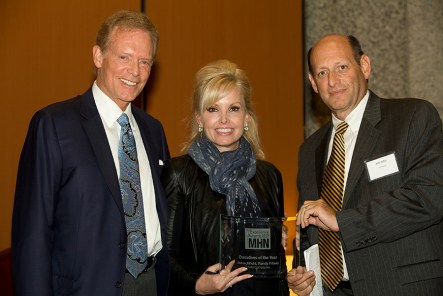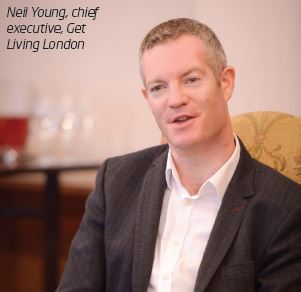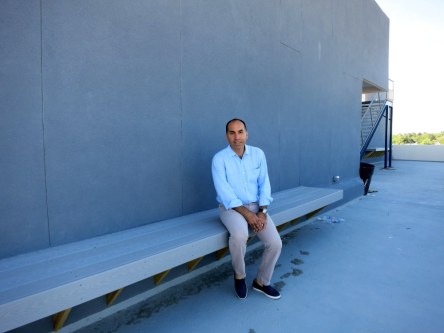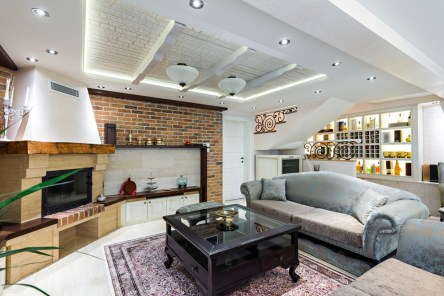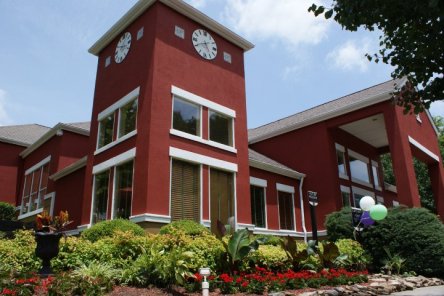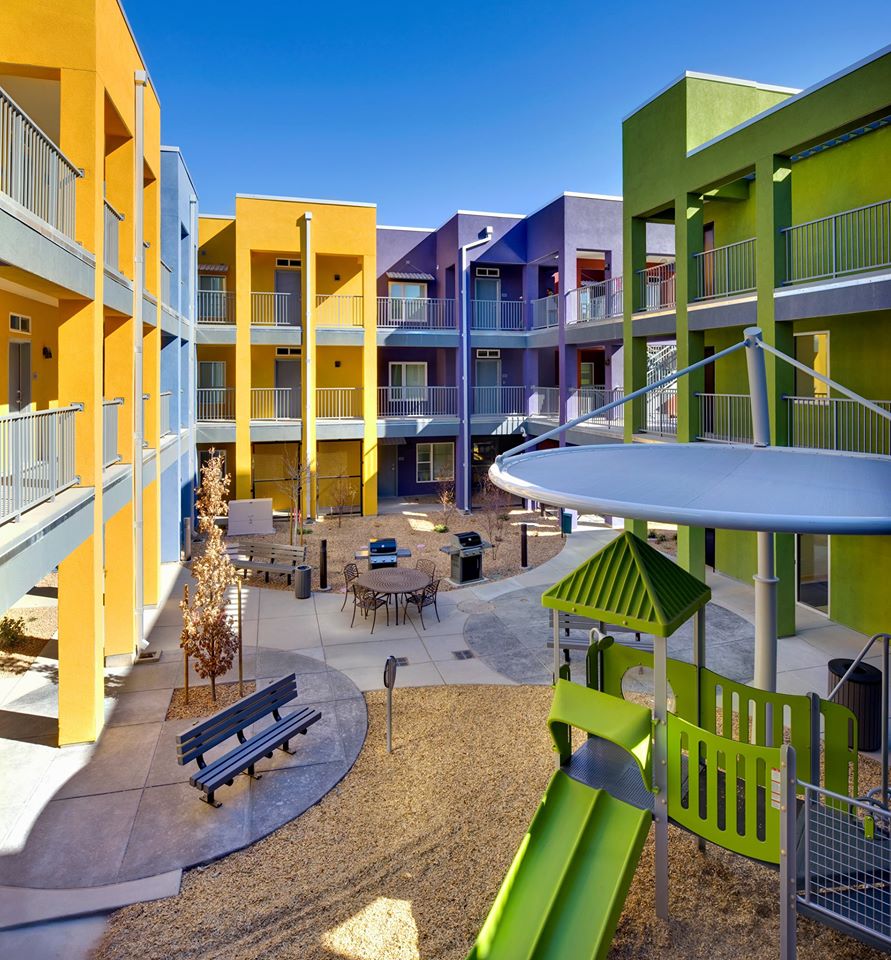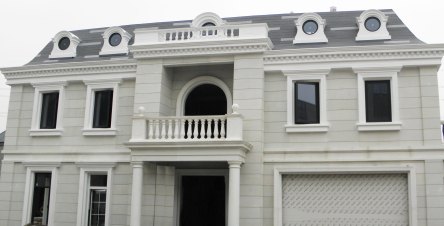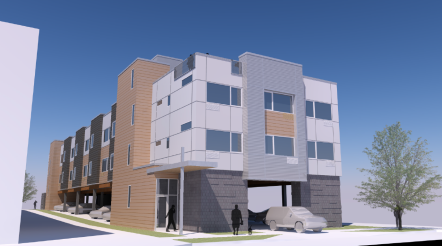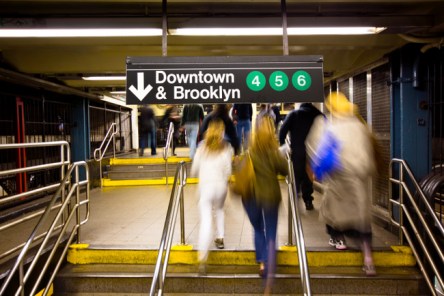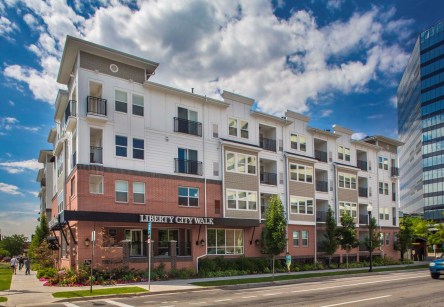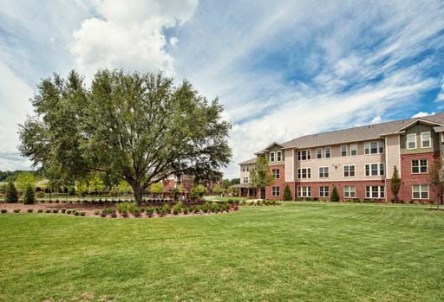No, we’re not talking about meeting our staff. (Although you can see a few lovely Yardi employee profiles here.) Today we’re talking about introducing your staff to your residents: how and why you should do it! Celebrating the employees that make your property a great place to live just makes sense. For one thing, it’s a good team building exercise. For another, it brings life and personality to your communities. Your property is more than just a collection of buildings. It’s a nice place to live, staffed by a group of people who really care. When you create that personal connection with both residents and prospects, you drive leases and increase retention. There are many ways you can share staff member stories with your audience. You might include a staff spotlight in your newsletter, showcase team photos on your Facebook page, or write an “employee of the month” post on your blog. Or you can create an infographic like the one we made below using Canva (it was easy, we promise) and share it everywhere—from your social media channels to your move-in email. If you use RentCafe as your property marketing platform, you can use the easy social media posting tools and email manager to get your infographic or message out in a snap. However you choose to showcase your team, here are a few tips to increase engagement: Focus on staff members that prospects and residents interact with, like leasing agents, property managers, and maintenance workers Include a photo – having smiling, happy faces associated with your property never hurts Add a fun tidbit that speaks to the unique personality of your team member Encourage residents to help you recognize exceptional employees via email and social media While we’re on the topic,...
Holiday Marketing
Property Management Strategy
‘Tis the season for… leasing? Sure! Any time of year can be a good time to ramp up your leasing and renewal efforts when you take a seasonal approach that builds relationships and excitement around your business. Make sure your occupancy rates don’t cool down this season with five holiday marketing strategies for residential properties: 1. Create a Holiday Ad Campaign Use resident reviews and testimonials to develop a “Call <Your Property Name> Home for the Holidays” print and online ad campaign. Testimonials help to humanize your community and advertise it in non-corporate language. Alternately (or in addition), you can run a social media contest that offers residents prizes for sharing what they love about living at your property. Encourage participants to use a dedicated hashtag. These posts will reach not only their friends and family but can be shared with your followers as well. And, if your property marketing website features Instagram integration, you can easily post these photos online. “Instagram really shows those lifestyle photos. The Instagram galleries on our property marketing websites let prospective residents know what it’s like to live in our communities,” says Mia Wentworth, director of marketing at Monarch Investment and Management Group. “Our residents help us post fresh content to our sites, without us having to send a special team to take photos.” 2. Treat Your Residents Advertise holiday movie viewings in the clubhouse from Thanksgiving through the end of the year on your website, via email, and as Facebook events. Provide snacks, drinks, and free company swag if you have some. Invite residents to bring friends, instantly opening your community up to new prospects. If you’re worried that an event won’t get much traction at your property, try delivering inexpensive pop-by gifts and thank you notes...
Michael Pestronk
Post Brothers Apartments
Over the last eight years, Michael and Matthew Pestronk, CEO and President of Post Brothers Apartments, have created a unique brand of Class A apartments for the Philadelphia market. Their latest major project is no exception. Presidential City, a John McShain project built in the early 1950’s that Post Brothers acquired in 2012 for $51 million, needed a fresh start. Updates had never been made to the 1,038 apartment interiors, and as Michael Pestronk says, “it just had not had any love in a really long time.” Kitchens were three decades old, bathrooms dated a half-century back. The first of four apartment towers was delivered this fall and is completely occupied. The $210 million redevelopment project is a complete renovation and reimagining of Presidential City. Each tower will have a unique theme and character, and the former Pool Club is undergoing a transformation to a world class spa and health club. “We’re making something that’s truly world class,” Pestronk says. Read on for more insight on Presidential City. This is a huge project. Can you put the size and scale in context? Pestronk: This is the largest residential development in the city of Philadelphia. Not just in the city proper, but also in the surrounding region. It’s located at the intersection of two of the heaviest trafficked highways in the region. It’s also very physically prominent. John McShain was from Philadelphia and built most of the monuments in Washington, D.C. He originally had a master plan to do 48 towers with something like 20,000 Philadelphia apartments. He built the first four, and eventually sold off the rest of the land. What is the overview of the renovation plan? Pestronk: We are not just renovating, but completely redeveloping. The outside façade of the properties looks...
Executives of the Year...
Steve and Randy Fifield
You may think the secret to success is money, recognition or luck, but Steven and Randy Fifield, MHN’s 2015 Executives of the Year, shared that their success started with peanut butter and jelly. At the annual Multi-Housing News Excellence Awards on October 14th at Club 101 in Manhattan, the Fifields engaged in a panel discussion with Yardi Matrix Vice President Jeff Adler (photo, left), and shared some advice, insights and anecdotes from their long careers in real estate as Chairs of the Fifield Companies. While discussing the ins and outs of experiential marketing, Randy said that in order to make apartment living attractive to busy professionals with money to spend, she’d serve peanut butter and jelly sandwiches to people who work in the area and would stop in on their lunch break. “What they do is they work in the CBD (central business district) and then they come home to let the dog out because we have beautiful parks around the neighborhood, and they’d eat peanut butter and jelly because they could talk on the phone and nothing would drip on them and they’d let the dog out, have this great life and then walk back to work,” she said. Obviously the road to success is not literally paved with peanut butter and jelly, but serving homemade sandwiches is just one anecdote that personifies the Fifields’ knack for giving renters what they want before they even know exactly what that is. It’s not an easy feat, especially in a market where the renters themselves are evolving almost as quickly as their demands are. “The median age has been moving up; 95 percent of the renters are college graduates. The median income in virtually all these transit-oriented urban projects has been over $100,000. It’s a totally different market,...
Special Delivery
Tech for Multifamily Mail
The holidays are coming… and with them comes a huge increase in resident packages! Are you ready? If that thought made you shudder a little bit, you’re not alone. Apartment communities and high-rise buildings see a dramatic influx of deliveries during the months of November and December. The question of how to deal with them in a way that will make both residents and staff happy is on every property manager’s mind right about now. First, we’ll take a look at some shipping stats so you can see exactly what communities just like yours are up against. Then we’ll identify challenges that every property faces. Finally, we’ll show you how simple technology solutions can help you handle shipments more efficiently. Because even Santa could use a hand during this time of year! The Stats Did you know that the typical apartment community can receive as many as 100 packages in a week—and that number can DOUBLE during the holidays? Last year, the National Multifamily Housing Council (NMHC) took a closer look at package delivery by the numbers. Take a look at their wonderful infographic below to see stats at a glance. We can only imagine that the numbers will be even bigger this year! The Challenges “When you receive 200 or 300 packages a week, it puts tremendous pressure on the staff to manage the influx of deliveries. And with 90 percent of retail sales still taking place in brick and mortar buildings, we’re only at the tip of the iceberg in terms of e-commerce,” said Rick Haughey, NMHC Vice President of Industry Technology Initiatives. The challenges that most community managers face regarding parcel deliveries really come down to three things: storage, manpower and resident notifications. Package storage: Where will you store packages after...
Yardi Think Tank
London's apartment market
LONDON – The burgeoning demand for rental property – particularly in London – means developers of build-to-rent schemes have a captive market, but everything else from valuation to finance and planning seems to be stacked against the sector significantly expanding. What do the pioneers of this form of development have to tell us about the state of the UK housing market and housing policy, and how are they overcoming the odds to deliver profitable schemes? Panel participants: Claer Barrett, Financial Times – Chair Dominic Martin, Operations & Strategy –Westrock Neil Young, Chief Executive – Get Living London Ryan Prince, Chief Executive and Co-Founder– Realstar Living James Scott, Chief Operating Officer –The Collective CB: There has been a lot of noise about ‘build to rent’ as a policy, but correspondingly little development in the private rented sector (PRS). Why is it so challenging financially? RP: It is uneconomic for PRS developers to compete with housebuilders. By our estimates, they can pay 30% more for a site. Then there is the time it takes persuading the planners. When you actually do the math, taking planning, construction, leasing risk and time into account, returns can actually be pretty poor. Most new PRS schemes are either government-procured PRS, where land is marketed on the basis that it will be PRS instead of homes for sale, or part of large-scale regeneration projects. If you remove those specific circumstances, you have no real meaningful, scalable policy framework to have a PRS industry in the UK. I think it gets disproportionate headlines relative to its size. DM: We still do not have clarity for PRS in the planning process. The London mayor’s supplementary planning document is starting to go in our direction, but it is still only guidance. Local authorities can do...
New Mexico Rising
Albuquerque's real estate trends
ALBUQUERQUE, NM – The Platinum is not your typical Albuquerque apartment complex. It is four stories, expected to be LEED-Platinum certified, with city and mountain views: in other words, a modern marvel that will draw some of the city’s highest rents. It’s surrounded by Nob Hill, Albuquerque’s most walkable urban neighborhood. The area is a mix of higher education, restaurants and service businesses along Central Ave., also known as historic Route 66. “This is Albuquerque’s main street,” says Rick Goldman, developer of The Platinum and two other nearby condo and loft projects. “Usually, retail follows rooftops. But in this town, you had retail on Central, but no rooftops to speak of.” Albuquerque has sprawling single family housing tracts spread across the city. High density apartments rising above two stories tall are rare. Your typical Albuquerque apartment complex, says longtime broker Todd Clark, “was built in 1970, is two-story, brick, with a pitched roof, master-metered and originally offered furnished. It’s an island surrounded by a sea of parking.” So is the Platinum a symbol of things to come in New Mexico? Maybe. But there are challenges ahead before Albuquerque can be considered a transit-friendly, walkable urban destination. Breweries and buses How can you tell when a city is poised for an influx of millennials? CBRE’s Billy Eagle, who specializes in multifamily sales, suggests that you might want to track brewery openings. “During the last two or three years we’ve seen the breweries expand five-fold. I think there are now more than 25 in town,” says Eagle, who relocated to Albuquerque from Southern California eight years ago, when he was in his early 20’s. He talks enthusiastically about cycling around downtown, weekly farmer’s markets, new restaurant openings and Uber: all hot with Millennials. During his time...
Better Protection
Requiring Renters Insurance
Think your landlord insurance is enough? Think again. Recent studies examined renters insurance practices at property management companies throughout the Unites States. Those reports suggest that 45 percent of property managers do not offer insurance to their tenants. Only 25 percent of property managers require their renters to purchase insurance at every property in their portfolio. Of the properties that do require renters insurance, The National MultiHousing Council’s Apartment Cost Risk Survey suggests that only 25 percent had a consistent standard for each property within a state. As a property manager, a lack of coverage and inconsistencies within coverage requirements will leave you vulnerable. By making renters’ insurance compulsory at each and every property, you can minimize costly risks–saving nearly 80 percent in repairs on renter-caused damages! Renters insurance supplements some often overlooked (or inadequately covered) areas in your landlord insurance policies including: flood earthquake residents’ housing after a disaster, while the property is being repaired lost rent while tenants are away during repairs tenants’ high-cost valuables guest accidents and injuries ResidentShield provides renters with the coverage that they need to rebuild their lives after a disaster or take care of a guest who sustains injuries while visiting the unit. This coverage can provide peace of mind for your residents while limiting your costs and liability. If you’re not currently requiring renters insurance, the next natural question may be, “Where do I start?” A gradual transition is essential for maintaining renter satisfaction while increasing your protection. Most property management companies phase the insurance requirement into existing leases as they are renewed. The increased costs will undoubtedly raise concern with some renters. One way to ease the transition is to offer options to your tenants. Some property managers may allow renters to choose their own prepaid policy rather...
Luxury Student Housing...
Upward Trend or Doomed Fad?
Student housing has grown into a $5 billion industry. Colleges and universities rely on private builders for housing, on and off campus. These private builders are best able to equip units with features that appeal to the new generation of student renters while keeping the institutions’ costs low. Yet with the rise of student debt and the accompanying public outcry, the glory days of luxury student housing may be short-lived. The dorms of today are nothing like what I grew up with at my private institution—and I’m barely 30. For freshman year, I shared a tiny, cinderblock room with a roommate. 15 rooms on our hall shared a commercial-style bathroom. If it weren’t for the laughter in the halls and all of the pretty decorations, we could’ve been confused for inmates. While the accommodations improved as I gained seniority, even some of the nicer rooms at my college pale in comparison to new student housing. Today’s freshmen face serious temptation. Common amenities are leaning more towards the luxurious than the utilitarian: saunas, steam rooms, tanning beds, infinity pools, lazy rivers, maid service, dietary-savvy restaurants, and onsite clubs are not uncommon in student housing throughout the nation. The College Board reports that the average cost of room and board in 2014-2015 was $9,804 for state schools and upwards of $11,000 at private schools. Students are high-risk tenants, so housing comes at a price, especially if you want a nicer lifestyle. Just how are students paying for these high rents? They aren’t. That’s part of the problem with the public’s reception of student housing. Students are digging themselves into debt at backbreaking rates. Most students aren’t working their way through college in the traditional sense. They aren’t working directly to cover expenses and graduate debt free. If they aren’t receiving...
Risk Management
Multifamily Roundtable
Apartment owners and management companies have a lot to worry about in keeping their communities safe and secure, and there are always new factors emerging to further add to the complexities of risk management. Multi-Housing News reached out to property owners, property managers and the insurance companies who cover them to see what the top risk concerns are in 2015, and the challenges of insuring those risks in the years ahead. What type of risk are you or your company most concerned about insuring against today? Mark Mascia: Cap rate expansion outpacing rental growth. The market has seen phenomenal growth in rents with limited new supply to slow it down. However now that cap rates are at historically low levels throughout most markets in the country there isn’t a whole lot of room for them to go anywhere but up. So as cap rates expand lowering the value of their property they need to keep increasing rents just to stay even on values. For longer-term cash flow owners this isn’t as much of a concern, but for REITS with mark to market pricing and for companies who had short-term business plans this is a real risk to their investments. Heidi A. Much: For Village Green, we’re trying to get our arms around our cyber exposure. We all use a multitude of providers in our industry—someone who does your accounting data, your rider insurance, your employee screening—and while we don’t necessarily have confidential information stored, we are using providers who have that information stored. We’re trying to understand what’s out there, what are they doing, what is their disaster plan and recovery plan? Steve Heimler: Number one is a data breach. Everyone is a target, and we do have information in the hands of a...
4 Lessons About Renters...
From House Hunters International
For a short list of reasons, which are relatively uninteresting, I’ve recently become obsessed with the HGTV show House Hunters International (and its parent program, House Hunters). A couple of years ago, it was revealed that the elimination process featured on the House Hunters program is somewhat contrived – participants apparently have often already selected their property before they become part of the show. That doesn’t bother me too much, because the episodes that I find most interesting are those in which the participants are looking for a home to rent, not buy. Often living temporarily outside of the U.S., the reactions of Americans to rentals in different countries is telling, and brought me to these realizations about our collective renters’ mentality, circa 2015. We are spoiled with inexpensive modern appliances. The kitchen seems to be the focal point of most apartment searches, especially for the female half of the prospect party. (Most of these shows feature a heterosexual couple, usually married, with a few exceptions.) Certainly, it’s nice to have a stainless steel oven or fridge, and no one can ever argue that a dishwasher isn’t an object of great convenience. But if the appliances function without burning the place down and allow you to cook food, are they really a deal breaker if they’re not new? In the case of many renters, apparently the answer is yes. Being in the city center is apparently overvalued. More often than not, the renters presented start out their rental wish list with the desire to be close to whatever attraction has brought them overseas in the first place (typically a job, educational opportunity, arts & culture or a beachside life). But when it comes down to maxing out their budget for other items on the...
Move to the Music
Lincoln Portfolio on Point
Countless studies examine and relay Millennials’ consumer habits, expectations, needs, wants and way of thinking. But there’s one thing that’s obvious without needing any study to uncover it: Millennials live and breathe music. While iPhone docks, great sound systems and entertainment lounges are all great amenities to offer, you can’t beat physical proximity to the finest venues for live music acts. For those looking to catch the best music acts at the most outstanding music venues, Los Angeles and Nashville are the places to be, according to the 26th annual Pollstar Concert Industry Awards, which celebrates the world of live music. One company that makes sure its music-loving residents are close to the finest music venues is Lincoln Property Company. As the second largest property manager in the United States and with 163,000 units currently under management, it’s easy to find a Lincoln Property-managed apartment near the best live music venues in the country. Los Angeles. Pollstar’s 26th annual awards show named the Hollywood Bowl Best Major Outdoor Concert Venue, Forum Inglewood the Best New Major Concert Venue, while the Greek Theatre snagged the Red Rocks Award for Best Small Outdoor Venue. For proximity to the world-famous Hollywood Bowl, it doesn’t get better than Lincoln’s The Avenue Hollywood. Located only 1.1 miles from the Hollywood Bowl, The Avenue sits on the western edge of Hollywood, offering swift access to countless music venues, nightclubs, art galleries, fitness spots, cafes, bars restaurants, shopping and farmers’ markets. Community amenities include a heated swimming pool, whirlpool, fire pit with high-end BBQ grills, fitness center, courtyard pocket park and a turf dog run. The Avenue also offers such concierge service and a bevy of other residents services ranging from pet grooming to auto detailing. The Avenue Hollywood celebrated its...
Property Management
A year of growth
The second quarter of 2015 has begun on a positive note for built-to-rent single family properties. Markets for existing single family rentals across the nation enjoy occupancy rates close to 95%–and these properties need managers. If you’ve positioned yourself properly, then success is well within reach. If not, here are a few tips to bring you up to speed. Build Bridges As your business grows, so should revise your list of industry contacts. By expanding your network of professional service providers, you will be better equipped to thoroughly meet clients’ needs in a timely manner. In a perfect world, you will already have an advanced understanding of federal, state, and local laws regarding fair housing, tax codes, and business regulations. But since you probably don’t have the time, energy or mental capacity to be an expert in everything, familiarize yourself with the aforementioned guidelines and then add lawyers that specialize in real estate and contract law to your inner circle of contacts. Inspectors also make good friends, since they can detect problems with your properties before they become lawsuits. Accessibility compliance inspectors, as well as those with expertise in building codes and environmental regulations are excellent contacts to have on hand. Be sure to have each property inspected every 3-5 years. As houses experience wear and tear, land shifts, and properties settle, a property can fall out of compliance. Without early detection, a property out of compliance can cost you millions. Let’s not forget your everyday heroes—you will need plenty of them. You probably already have a strong relationship with a local handyman, electrician, and plumber. Consider adding at least two more professionals from every county in which you plan to expand. This way, you won’t exhaust your current contacts and you won’t have all of your eggs...
Five Affordable Cities...
Ripe for putting down roots
“New York apartment market stays white-hot,” “Seattle multifamily development on a roll,” “San Francisco rents through the roof,” – we’ve all read the headlines. We come across them daily, as the nation’s top metro areas continue to post high rent growth numbers and apartment projects continue to pop up all over America’s large urban centers. While the apartment market’s rebound and growth has undeniably brought great economic improvements nationwide, it is just as undeniable that the past few years’ explosive growth in the country’s top markets has led to pervasive housing affordability issues. While incomes are overall more substantial in large urban centers, so are living costs. With half of America’s renters spending 30 percent of their income on housing and a quarter spending over 50 percent of their income on their apartments, unaffordability is a hot-button issue. The good news is there are a few pockets in America, where housing and living costs coalesce with employment opportunities for affordable living. According to a recent Forbes analysis, many of America’s affordable cities are located in the South and Midwest. We’re taking a look at some of the housing options available in the five most affordable cities in the U.S. as established by Forbes. Birmingham, Alabama Named the most affordable of the nation’s 100 largest metro areas by Forbes, Birmingham, Alabama is boasts a median family income of $61,000 which means that you can live in style in the largest unit available at Arium Inverness, and still brag about having an affordable apartment. That’s right, this stylish community’s largest units, which clock in at 1,400 square feet, charges between $915 and $1,085 per month. That bargain deal includes three bedrooms with a loft, two bathrooms, a dining room, a balcony and den. Other posh features...
Making a Move?
5 Great Cities for 2015
Major metros are great, but the U.S. is also home to dynamic second and third-tier cities that offer strong economies, booming job markets and unique local culture. Many of the nation’s smaller metro centers are brimming with business opportunities and the chance to be part of positive change. The Huffington Post recently nominated five such cities as the it travel destinations of 2015: Portland, Ore.; San Antonio, Texas; Raleigh, NC; Albuquerque, NM; and Denver, Colo. Of course, the movers and shakers of the multi-family industry have already taken note, so Portland, San Antonio, Raleigh, Denver and Albuquerque boast excellent apartment communities. Raleigh With over $2 billion in apartment sales and $3.6 billion in commercial sales, according to Colliers International data, it’s no wonder the Research Triangle is a hot place to be. Among the hot new tickets in town is the 216-unit Amelia Station Apartments, which had its grand opening in December 2014. Part of the Drucker & Falk Real Estate portfolio, this luxury apartment community comprises one-, two- and three-bedroom units ranging between 700 and 1,300 square feet. Amenities include a resort style pool complete with poolside entertainment plaza, outdoor grilling pavilion, 24-hout fitness center, 24-hour business center, 24-hour billiards room, children’s playground, leash-free bark park, concierge services and a car wash station. Portland Banking on Portland’s growing popularity, Wood Partners entered a development partnership with Hoyt Properties in late 2012 to develop Block 17, the newest addition to Portland’s LEED-certified Hoyt Yards neighborhood. Set to open in fall/winter 2015 in downtown Portland’s Pearl District, the 281-unit luxury community is steadily rising near the three-acre Fields Park, which will provide ample outdoor green space for future residents. Comprising a 16-story high-rise and a five-story mid-rise and featuring floor-to-ceiling windows, Block 17 will...
Property SOS
From Dated to Desirable
As much as we applaud new multifamily construction here on The Balance Sheet, we realize that it’s not good news for everyone. Owners of dated properties know that the new, shiny rentals up the street with the unbelievable move-in deals may create stiff competition. Fortunately, a few strategic updates can help your aging property feel fresh and appealing. Add your excellent rents and stellar onsite staff and those new properties won’t know what hit them. Take that, shiny new properties! Floors Skip costly hardwoods and carpets that need to be replaced with every new lease. Instead, opt for porcelain tiles. There are plenty on the market now that give the look and feel of hardwoods with even fewer care requirements. Just be sure to shop around; there are affordable options that look just as great as high end products that would break the bank. Kitchen & Bath Give aging cabinets a new breath of life with a fresh coat of paint and trendy new hardware. White and gray paints leave kitchens and baths feeling crisp, clean, and modern. As for hardware, keep the designs sleek and simple—and avoid anything shiny. Thanks to a growing appreciation for all things old school (an heirloom left to us by the hipsters) even old tile can look intentionally chic. The secret is in the grout. Tiles look dated when the grout is stained and disintegrating. Re-grout tiled areas and take the opportunity to replace any cracked or chipped tiles. New grout costs a lot less than completely renovating a bath or backsplash. While minimalist design looks great in magazines, most renters will admit that they have stuff and that stuff needs a home—like drawers and cabinets. Give bathrooms an ultra modern feel with cityscape cabinetry. These cabinets...
Leads to Leases
Fast-forward the conversion cycle
You’ve followed the online marketing basics: you have a website with property contact info and pictures. You set up social media accounts and add some new content every week. But now you’re frustrated because your efforts aren’t paying off. What can you do? SatisFacts 2015 Online Renter Study promotes a better understanding of today’s “online resident and prospect,” the largest segment of apartment renters in the US. The company analyzed more than 7,600 renter responses representing over 21 property management companies. Answer these questions to learn how SatisFacts’ research could boost your conversion rate. Can prospects find you? First and foremost, you have to make sure that prospects can find you online, anywhere. If your website isn’t WAP-enabled and HTML5 coded for mobile, you’re missing out on the 60.1 percent of renters who use mobile devices during their rental search. Odds are, renters aren’t typing your URL directly into the address bar when they search for apartments. That means your presence is vital on listing and review sites. 68.8 percent of renters search ILS and 45.4 percent seek guidance from rating and review sites. If you’re not listed in both locations, you’re being overlooked. Did you set your best foot forward? Make sure that you offer recent images and up-to-date information, especially when it comes to the availability of apartments. Renters want all of the information needed to make an accurate decision on the spot. The absolute best-case scenario is to provide prospects with photo or video tours of the unit that is available for rent. Your immaculately staged model doesn’t impress them. Viewing the actual apartment has the #1 greatest impact on a leasing decision whereas viewing a furnished model falls at 12th place. With such information available online, about 10 percent of renters will decide to sign a lease site unseen. Do you have a good rap? For the remaining 90 percent who want more information, they’ll start looking around for real-world recommendations. 74.4 percent of renters trust referrals from their friends and co-workers. 67.7 percent put their faith in online reviews. This means that it’s more important than ever to kick your referral system up a notch. Provide incentives for existing residents to make referrals, such as lease discounts or prize giveaways. Since face-to-face referrals have such high success rates, they deserve greater incentives. You can also incentivize participation in forums and social media. Residents don’t necessarily need to make up glowing reviews. Honesty is best since more than half of renters would not trust a review site if all or most of the reviews were positive. Instead, offer small incentives (gift cards, for example) for social media engagement that includes balanced feedback on the property and staff. Don’t be afraid to ask for feedback. 61 percent of all renters are willing to post a positive rating or review! Once you’ve rallied feedback, promote the characteristics revealed in the positive reviews and set out to rectify the concerns expressed in negative feedback. When renters see that apartment community staff has constructive responses to negative feedback online, 57 percent conclude great things about the community’s customer service and 49 percent feel your company “really care about their residents.” Now you’ve got their attention! All of the work that you’ve put in simply formed your first impression. Prospects have flown through it in a matter of minutes! Now they’re ready to show up at the leasing office and take action. Coach your onsite team on these communication skills. Now you’re ready to turn a prospect into a loyal...
Excellence Awards
Nominations are Open
MHN Excellence Awards recognize the multifamily industry’s most noteworthy people, companies and properties. The 2015 winners will be selected by a panel of judges representing expertise across all multifamily disciplines. Submissions will be due by Monday, June 15. Here’s how to enter. 1) Select the categories you’d like to enter and click to download those entry forms for rules and instructions; • Executive of the Year • Property Manager of the Year • Leasing Agent of the Year • Development Company of the Year • Property Management Company of the Year • Best Brokerage Office • Transaction of the Year • Best Apartment Community • Most Tech-Savvy Community • Best Marketing Program • Best Value-Add Renovation • Best New Development and Design • Best New Development: Unbuilt 2) After completing the entry form(s), click here to upload form and submit payment online. (You still have the option of mailing us your entry as hard copy in a binder and/or paying by check; follow those instructions after you download the entry form from the list above.) If you have questions, contact Diana Mosher, Editorial Director at [email protected]. Finalists will be announced in August at multi-housingnews.com and winners will be announced in September at a special event in New York and published in the October issue of the magazine. All winners will receive a personalized award for display in their office or multifamily...
3D Printed Apartments...
A reality in China
Gutenberg invented the printing press in 1439; since then the printing industry has evolved, from printing blocks to 2D printers with the capacity of mass-producing documents in just minutes. Today, 3D printers are capable of creating pretty much anything, from mechanical parts to prosthetics to buildings. Even though it’s been 32 years since an engineer named Chuck Hull invented 3D printing, only recently the process became one of the industries of the moment for investors. From 2011 to the present day 3D printing has raised almost $4 billion, while during 1987-2010 (23 years) it raised only $300 million. Increase in interest by public investors translates into extraordinary potential and profit in the industry. 3D printing advocates say the technology will be routinely used to build homes, food, and human tissue and believe that it has the potential to revolutionize how we do everything. A good example is General Electric, which announced that it is using this technology to make the next generation LEAP airline engine that will save fuel consumption and expense. Probably the even better news is that 3D printing is no longer reserved for corporations only, but available to all. A Chinese construction firm, WinSun Decoration Design Engineering, unveiled a five-story apartment building, dubbed “the world’s tallest 3D-printed building,” along with a 11,840-square-foot neoclassical mansion, both made entirely with a giant 3D printer. The properties were built with a patented ink created from a combination of recycled construction waste. This project follows last year’s revolutionary initiative when the company built 10 affordable houses in 24 hours, each of 650 square feet at around $4,800. For the affordable project the company used four 3D printers that measure 20 feet in height, 33 feet in width, and 132 feet in length. The process is...
Introducing iUnit
Modular + Energy Smart
Believe it or not, iUnit is not the next device a certain ubiquitous technology company wants you to run out and buy. Rather, it’s a new modular housing project coming to Denver, Colo. in 2015, blending smart energy use, wireless connectivity, green construction and the urban living preferences of American Millennials. iUnit is intended to challenge the way we think about apartment living today, says founder Brice Leconte. A Washington, D.C. entrepreneur with a passion for startup technology, Leconte is currently an Entrepreneur in Residence at the University of Maryland as well as an advisor and mentor at Georgetown University. “iUnit is really a reflection of how I see the world and what I want to do with commercial real estate,” said Leconte, who worked on large single-family home developments early in his career. iUnit at Highland Park is his first foray into the multi-family space. We recently spoke to him about the project and what makes it unique. Tell us about iUnit. What’s it all about? Leconte: There are a lot of things in real estate that don’t make sense to me. One of them is on the modular front – why we are still building buildings out in the elements, while they are being rained and snowed on. I’ve wanted to build differently for a long time, and modular construction has always made sense to me. Building in a controlled environment, we end up with a much better, greener product, and better worker safety. That’s the method we’ve chosen for our multi-family building. We will use a factory in Idaho for the module construction. The other thing that has never made sense to me has how commercial real estate has lagged behind in integrating technology into its buildings. How can we introduce...
A Screening Solution
Landmark Realty of San Francisco
There aren’t many parallels to be drawn between the rental markets of San Francisco, Ca. and Albuquerque, N.M. One is known as the home of Twitter, the other as the setting for Breaking Bad. Last month, average rent for a San Francisco one-bedroom was $3469. In ABQ, a comparable pad could be had for $878.* Landmark Realty, a San Francisco-based multi-family based owner/manager with the bulk of its assets in California, has buildings for rent in both metros. And finding the reliable resident who can afford San Francisco’s high prices is just as important as identifying the on-time rent payer who will stick around for the duration of their one-year Albuquerque lease. To identify qualified candidates in both cities, Landmark relies on Yardi Resident Screening, a resident review service that’s built in to their Yardi Voyager® leasing workflow. Yardi Resident Screening allows Landmark to deliver quick, accurate screening to applicants applying to lease at their properties. Landmark Realty Controller Larry Busgeon says that one of his favorite features is the ability to select unique screening criteria for every property type in Landmark’s nationwide portfolio. “Our Albuquerque properties are lower-end so we’re not worried so much about credit score as we are history of tenancy,” Busgeon explained. “San Francisco, of course we want (strong) credit scores because the rents are much higher there, and we want to see some history on that credit score.” Landmark also has a mixed portfolio of apartments in Kansas City, Mo., a market that presents its own set of challenges. Resident Screening offers highly customizable functionality and much more. Using the most reliable data available, Yardi Resident Screening provides automated recommendations that minimize risk. In San Francisco, Landmark uses it to screen long term residents, and is now expanding use...
Raising Fees
How to break the news
Increasing fees without losing tenants is all a matter of presentation. When the economy slumped, many businesses explored ways to cut costs and stay afloat. Some property management companies offered fees as low as 4 percent in exchange for basic services. Owners jumped on these contracts, using the low costs to attract renters to their properties. Now, as supply lags behind demand in many cities, it’s a managers’ market. Some are raising their fees and exploring ways to improve the services provided to owners. This creates the ideal opportunity to re-evaluate your property management services. Can you provide residents with the online and mobile conveniences offered by other properties? Are tenants satisfied with property upkeep? Taking advantage of improved management services could lead to higher quality tenants, longer-term tenant retention, greater tenant satisfaction, and less hair pulling on your part. Improved services will likely lead to higher fees from your service provider, typically between 8-12 percent. Pass those increases on to tenants; when you can offer more to your residents, you can ask for more in return. It’s important to make sure that residents still feel that they are getting a great deal. Their perception depends on your presentation. You are willing to sign on to a better management contract with higher rates because of what you will gain. Likewise, it’s important to let renters know what they’re gaining as the costs increase. That’s not to say that the improvements offered must directly correlate with the change in fees. Announce the increase in fees at the same time as other property improvements. Tenants will connect the slight raise in payments to tangible improvements. If you’ve planned to pressure wash exteriors, paint, redesign landscaping, update appliances or resurface the pool, this is the perfect time...
Top 20 Cities
For Walkable Urbanism
By now, you’ve probably heard that pedestrian-friendly access is all the buzz among Millennials and hip, active empty nesters. Mortgages and car notes are falling out of favor as these two large portions of the population steer towards rentals in walkable cities such as Seattle, Portland, and New York. A new study shines light on a few cities that are highly walkable and woefully overlooked. “Foot Traffic Ahead: Ranking Walkable Urbanism in America’s Largest Metros,” by Christopher B. Leinberger & Patrick Lynch of The George Washington University School of Business takes a quantitative approach to walkability in urban environments. Researchers evaluated the top 30 metros based upon the 2012 Brookings Institution methodology that pre-defined WalkUPs on geographical and economic terms. The selected cities were evaluated based upon economic performance and social equity performance. The findings were then used to rank the metros by current walkability and projections for walkability in the future. The 30 selected metropolitan areas are home to 46 percent of the population. Those metros also account for 58 percent of the national GDP. Interestingly, only one percent of all metropolitan land classifies as a WalkUP. If one percent seems unreasonably low to you, there is good reason for that. WalkUPs exclude owner-occupied spaces such as universities, medical centers, federal and state government buildings. There is not a consolidated database for such complexes from which researchers could pull information. This means that nearly 30-40 percent of employment spaces were excluded from the study. The current top six metros achieved Level 1 status, demonstrating the best distribution of walkable space in the urban core and surrounding suburbs. Level 1 listings represent 48 percent of all WalkUPs in the US. Within the rankings, cities such as Washington, D.C. outrank hipper destinations like...
Cowboy Properties
Happy residents on the range
Salt Lake City-based Cowboy Properties, Inc. has been managing apartment and condominium communities for decades now, attributing its success to its resident-centric take on business. “It all starts with happy residents. As simplistic as this principle may seem, at Cowboy Properties we’ve made happy residents our highest priority,” the company boasts. Cowboy Properties defines resident’s happiness as peace of mind, achieved through “responding quickly, and following through completely, to service requests,” as well as “respecting the trust that has been placed in us when a resident chooses one of our communities as home.” Cowboy Properties currently manages 20 apartment communities of around 3,000 units throughout the West, in Utah, Nebraska and Colorado. Utah is the focal point of Cowboy Properties’ activities, managing 16 completed communities in large urban hubs such as Salt Lake City and Park City as well as in smaller urban areas such as Sandy or Draper. Cowboy Properties manages the communities of affiliate Cowboy Partners, one of the top multi-family and mixed-use developers in the West. Cowboy Partners traces its organizational roots back to the 1950s. Projects developed by Cowboy Partners and managed by Cowboy Properties include Tregaron Senior in Bellevue, Nevada, Woodlands in Ft. Collins, Colorado, Liberty Peak in Park City, Utah and Liberty CityWalk in Salt Lake City, Utah. Cowboy Properties believes not only in a resident-centric business model, but also in giving back to the community. The company’s Cowboy Pledge initiative aims to connect residents looking to get involved and share their resources to give back to the community. The causes championed by the Cowboy Pledge are as varied as are collecting food bank donations, planting trees in local parks, assembling and donating backpacks with school supplies and helping redecorating patient rooms at the Ronald McDonald House. Residents...
Walton Communities
Family Friendly Apartments
Since peaking in 2004 at 69.4 percent, U.S. homeownership rates have been slipping year after year. According to the latest Census Bureau data, the third quarter of 2014 ended with a nationwide homeownership rate of 64.3 percent, marking the lowest rate in 20 years. As a result, rentership is becoming more and more ubiquitous and not only among single, newly graduated Millennials and empty-nest Boomers, but child-rearing Gen Xers as well. Moreover, as the economy continues to recover and Gen Y ages, a growing number of Millennials are expected to start new households and families, continuing to fuel demand for family-friendly communities. One company that is focused on offering residents and their families a nurturing environment is apartment developer, owner and manager Walton Communities. The Marietta, Ga.-based company boasts a portfolio of 23 communities that include market-rate, mixed-income, signature and senior apartments throughout metro Atlanta and Augusta, Ga. Walton Communities on track to open three additional projects in fall 2015. The company strives “to develop real estate in a way that builds strong communities and improves quality of life.” Its commitment to family friendly living is even woven into the company name, which was inspired by The Waltons, that back-in-the-day TV drama starring America’s favorite family. A great example of Walton’s commitment to family-friendly living is the 181-unit Walton Oaks garden-style apartment community in Augusta, which recently opened a 106-unit second phase. Family friendly features include a lending library, controlled access for increased security, playground, picnic area with tables and grills and landscaping that includes over-sized oak trees. Clearly, families are encouraged to spend quality time together outside. Energy efficiency appliances help keep monthly expenses down, while a pet-friendly community policy allows children to enjoy the perks of suburban living. Walton Oaks, like many...




